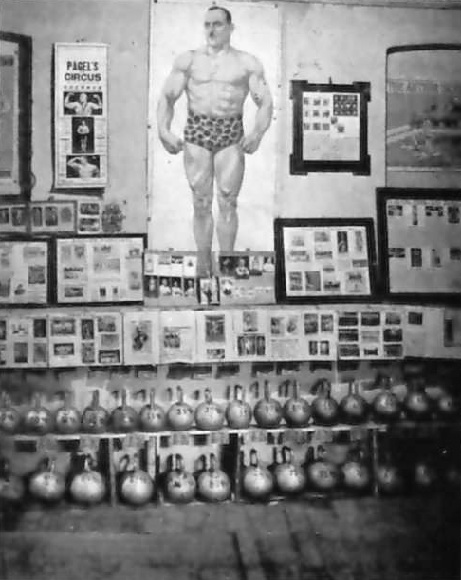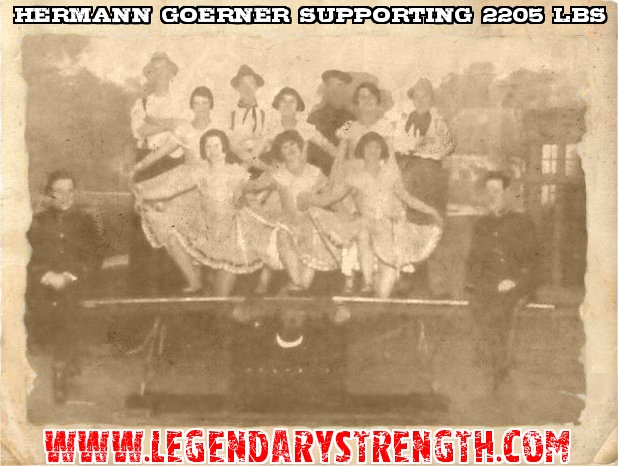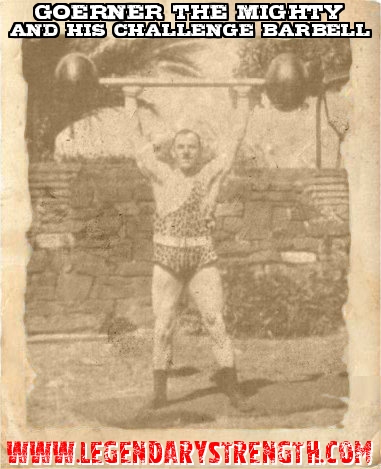You may find this surprising but this is the first time that I have read Goerner the Mighty. It’s a shame, because this is a very awesome book. It was written by Edgar Mueller a close friend of Goerner and someone that spent a lot of time with him. He was also quite the strength historian able to pull up all kinds of facts of Goerner and many other oldtime strongmen of the time.
The book is well written in that it gives you plenty of feats performed by the man and lots of information on his training. Sadly, not all of the oldtime strongmen books are this detailed. Here is a list of the chapters:
- Introduction
- His Early Life
- His Later Life and Travels
- His Measurements
- His Lifting Performances and Feats of Strength
- His Training Methods
- His Attitude to Strength Feats
- Appreciation by World Famous Authorities
Some of his Greatest Feats of Strength

Wrestling with an Elephant. Part of his daily act with Pagel’s Circus, South Africa. The elephant weighed 700 lb. at the comencement of the tour and had increased to 1500 lb. by the end of the tour, but was handled just as easily by the mighty Görner.
Does anything more need to be said then the fact that he was WRESTLING AN ELEPHANT!!!!
It should be stated that he was the only strength athlete in the world who, over a period of twenty years, could do at any time of the day or night, a Two Hands Clean and Jerk of 330 ¾ lb. on his Stage Barbell – without warming up! As has already been stated, this Barbell possessed a shaft of 2 3/8 in. in diameter, a fact which made this feat even more meritorious.
This shows his ability to exert high levels of strength, including phenomenal grip strength, without warming up. What was easy to him, was impossible for most.
At Dresden on 25th July, 1920, Görner lifted the enormous weight of 430 lb. (a little more than 195 kilos) overhead in the Two Hands ‘Anyhow’ style, performing the feats with four kettleweights in the following manner. He first of all swung with the right hand two kettleweights, one weighing 110¼ lb. and the other 99¼ lb. Still holding the bells overhead, he then bent down and picked up with the left hand a third kettleweight weighing 110¼ lb. (50 kilos), which he then swung to arms length and transferred to the thumb of the right hand. Then, still holding the three kettleweights overhead in his right hand, he lowered his body carefully and with the left hand picked up the fourth kettleweight, which he slowly swung to arms length. The combined weight then held overhead for the referee’s court was, as has been stated, no less than 430 English lb. or more than 195 kilos. This was a truly stupendous feat of strength…No man in the world has ever lifted more weight in the shape of Kettle-weights in the ‘Anyhow’ style than Hermann Görner
This is one of my favorites that I was not aware of before. This is just about as legendary as Saxon’s Two Hands Anyhow with a barbell and one kettlebell. If you think you’re good with kettlebells try this one, even with weights half the size.
A lift which never failed to impress his audience was his performance of the Two Hands Snatch with crossed arms. When lifting in this style, Hermann gripped the Bar in the centre with his hands touching, the left arm overlapping the right. In Leipzig on 5th December, 1919, lifting in this fashion, he snatched a Barbell weighing 231½ lb. – an amazing feat of strength.
Try a crossed arms snatch with an empty bar and you’ll get an appreciation for this feat. Basically in order to do this, much of the movement is more front raise, then snatch. And Goerner’s shoulder strength was that impressive that he could do feats like this and others.
On 21st December, 1931, we saw him take a barbell of 330.75 lb., Clean and Jerk it and then allow it to drop from arms’ length to the back of his neck – the bar which was 1 3/16 in. in diameter immediately became a “cambered” bar!
This to me is beyond words, except maybe ouch. Just imagine the amount of practice, and thus toughening up the bone, required to make this feat not snap you in half, literally.
He has written his name on a blackboard with a kettleweight of no less than 110¼ lb. (50 kilos) dangling from his thumb!
There are so many amazing feats of strength listed that I couldn’t possibly even include all the one’s that I found especially amazing. Check out the full book and read it. You won’t be disappointed.
Kettlebell Juggling Feats
Two kettleweights swung from the ground, thrown in the air and allowed to spin before being caught again by the handles, total weight 220 ½ lb.
Kettleweight of 50 kilos thrown and spun with the right hand, the bell turning three times on its own axis before being caught with the right hand. This feat was also performed with the left hand.
Kettleweight of 77½ kilos (171 lb.) thrown and spun and caught with the right hand. As far as is known this is believed to be the heaviest kettlebell ever juggled by any strong man in the world!
Kettleweight of 110¼ lb. (50 kilos) held in the right hand and without moving the feet thrown in shot-putting style a distance of 12 ft. 1 2/3 in.
As a great kettlebell juggler myself I was hugely interested in his feats here as most if not all probably still stand as records today. In the future though I aim to make that not true. 🙂

If you look closely at the kettlebells, you’ll notice they have smaller handles then those of today (even competition bells) which likely made some of his feats slightly easier. Not to take anything away from him, just an observation.
On Effort in Training and Setting Records
In performing the greater majority of his many amazing feats, very rarely exerted himself to anywhere near the limits of his astounding power. In many cases, he could have exceeded the Lift he made at the time of performance by a further attempt, but this he always refused to do.
This is an important distinction from the training of many people. Not only do they go all out in their training, but certainly when put to the test. Goerner was different.
It reminds me of a quote of Frankie Faires and I’m paraphrasing here, “Train inside your limits and you’ll never reach your limits.” What this means is that if you don’t find what your limit is, but train in a way that keeps things easy, your limit will continue to grow. It reminds me of when I added about 75 pounds to my deadlift in one summer. Every time I did set a max then it was easy and I could have done more, but I didn’t.
Reading this here was a great reminder of this principle of training. (And yes I would call it a principle.)
On Diet and Sleep
“To keep Hermann in the pink of condition, he needed sufficient sleep, as much as 4 ½ lb. of minced meat with eggs thrown in to help along.”
Görner is firmly convinced that a mixed diet is the best for a strong man, with emphasis laid on eating good meals with the accent on meat!
So Hermann was one to have a high intake of meat and protein as part of his regular diet when training.
Goerner’s Training Methods
It opens up with a paragraph saying the different amounts of training days he had. Sometimes daily, sometimes five days a week, sometimes four.
Each training session averaged two hours when performed in the Club, and when training in the open air it would vary between three and four hours – sometimes even longer.
This certainly flies in the face of the idea that you can’t train more than an hour. I firmly believe that to become the strongest you have to smartly train a lot more than the average person. Sure you can become ridiculously strong off an abbreviated schedule of one to two hours a week, but to become Goerner strong you need more. He wasn’t the only one to train like this either. Saxon did much the same.
It may be a matter of interest to note that when training in the open air at the Germania Bath, Hermann would sometimes conclude his training by having a swim, and at other times he would take a swim first and then carry out his training with the weights. He would not dry himself after bathing but permit his body to dry by the action of sun and air upon it.
This sounds like a great combination way to train. When you are training for several hours you can’t do the same thing over and over again, at least not regularly. You MUST mix up what you do. This will also serve to balance and even out your body. Multi-hour training allows you to really work on everything.
He trained always as the mood took him – varying his programme to suit his energy and condition of the moment and never did he force himself to perform any workout when not feeling just in the mood…He did not have or follow what might be really termed a “set” training programme…He did, of course, use a planned and progressive programme but he did not, as many do, map out a certain number of lifts with a certain poundage and then perform them a set number of times for a given period.
Here is a call for an intuitive type of training. Goerner didn’t have set-in-stone plans. He had general things he usually worked on but had tons of variation. Just look at the deadlift programs that are in the book, showing you all the unique ways you can train. It’s the same but different. This is why he was capable of 727.5 lbs, which stood for a long time as a record, and he didn’t even like the lift!
“Each training session of Hermann’s contained a mixed programme of kettle-bell, dumb-bell and barbell lifting…His inventive mind was always scheming out new and different ways of lifting all kinds of weights.”
Another call for variety and for working on lifts outside the normal box. Looking at his many feats you can see just how inventive he was. I believe that this amount of variation was partially responsible for his great strength.
Thus might end a typical work-out covering two hours – working fast all the while and not pausing to “natter” during his training session. Hermann did his talking and discussing after his work-out was over for the day.
This shows focus on the training while it is being done. This is also a big component to getting the most out of your workouts.
Hermann favoured low repetitions – usually 3 and very rarely 4 – with the weight being increased by 5 kilos (10 lb.) after each set. He trained for quality of muscle as opposed to quantity – that he also got quantity in the process was, as far as he was concerned, purely coincidental!
So here we have some ideas of his rep and progression schemes. Of course, this is usually, and with a man like Hermann we know he did a whole lot of variation on this as well. Also this was specifically written in regards to the Olympic lifts, at that time the press, snatch and clean and jerk with both two and one hands.
A Workout
If you’ve heard of Goerner the Mighty there’s a good chance you’re familiar with this workout called The Chain.
He would usually start by working out through what in Germany we call “Die Kette” – The Chain – but this is no ordinary chain. Let me try and describe it for you. Down one side of the gymnasium is a row of kettleweights – a total of nineteen – the first one weighing 13 kilos (about 28.5 lb.) and the last one 52.5 kilos (about 115.75 lb.). The whole row of kettlebells were paired off, except the last and heaviest one, giving a gradual increase of approximately 5 to 10 lb. per pair. The final pair of kettle-weights weighing 220.5 lb. (100 kilos) together. The kettleweights were placed in a row on the floor of the gymnasium, and working “Die Kette” (or The Chain) meant that Hermann would start out by taking the first kettleweight in the right hand and swinging it to arm’s length overhead, after swinging it, the weight would be lowered to the shoulder and then pressed up again overhead, relowered to the shoulder and from there to the “hang” and then curled to the shoulder, then pressed overhead again and finally lowered again and replaced on the floor. He would then repeat this with the next kettleweight, using this time the left hand. The whole length of The Chain would be worked through in this manner – in Hermann’s case he would lift all the bells in this fashion with the exception that he did not curl the last and final kettleweight of 115.74 lb. – but he could curl both the 110.25 (50 kilos) kettleweights! Other members of the Club would work through The Chain as far as possible – stopping only when limited by their strength.
Conclusion
After reading Goerner the Mighty you can understand why he was regarded as not just one of the strongest men in the world, but possibly THE strongest man in the world by many. This is one book I’m sure to read again and again.
Please write in your questions, comments and what you found most fascinating about this book below.






Comments
Interesting stuff. I’ve read this a couple of times and always wondered how much weight he was bearing in the elephant stunt. Lots of people put Goernor on about the same level as Saxon, but he seems to be even less well-known, perhaps because he just missed out on the “golden era”.
I was really impressed by the variety of feats Goernor performed. This is a biography; it isn’t going to focus on handing out set routines, but it does give a training philosophy and it’s a philosophy which really encourages all-round strength. I suppose in this sense he is again comparable to Saxon, whose book recommended excelling at a variety of lifts. We can’t all take several hours out of each day to train but we can pretty much all take a few of the ideas in the book and use them to improve ourselves, I certainly plan to.
@Dave: In the book it mentions the hard part about the elephant was it’s rough skin which would tear his skin up.
I’d say it seemed like Goerner did even more variety than Saxon, but they’re both big proponents of it.
I am shocked you never read this book. I saw a picture or read somewhere of him getting underneath and strapping a 1450 lb piano to his back and walking on all fours carrying the thing.
Pingback: Louis Cyr - The Strongest Man That Ever Lived Book Review